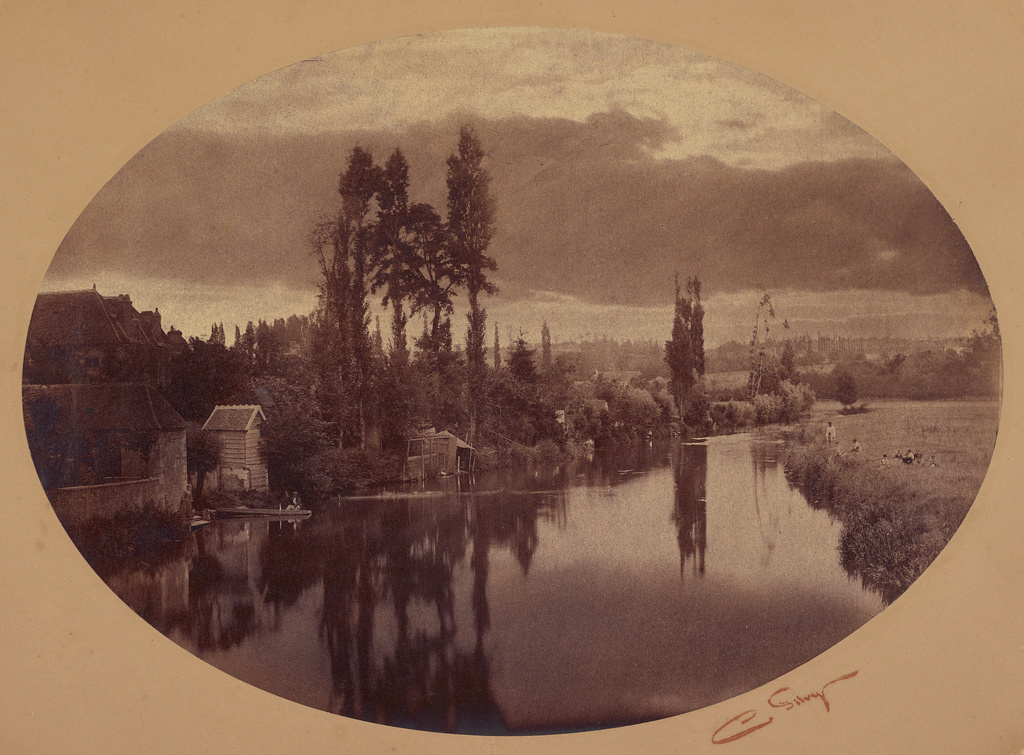Camille Silvy was born into a distinguished family of Italian descent in Nogent-le-Rotrou, France, about thirty miles from Chartres. Just one year later, in 1835, Silvy’s father resigned as mayor of Nogent-le-Rotrou and moved the family to Paris when he was appointed director of the Parisian bank Caisse Hypothécaire. The younger Silvy would, however, return often to the village of his birth for family visits and would eventually make a number of photographs there.
Silvy took up photography in 1857 during a trip to Algeria hoping to compensate for his “inadequate” drafting skills. One of his most stunning photographs, River Scene—La Vallée de l’Huisne, was made in 1858 and is known to survive in four large-scale prints, each distinct in appearance. These prints are in the collections of the J. Paul Getty Museum, Los Angeles; the Victoria & Albert Museum (V&A), London; the Société Française de Photographie, Paris; and the Musée Municipal du Château Saint-Jean in Nogent-le-Rotrou, France. Inspired by painters of the Barbizon School, Silvy’s four versions of this subject are the photographic counterparts of experiments by Corot and Daubigny with the cliché-verre and etching.
As photo historian Mark Haworth-Booth discovered, each of Silvy’s River Scene prints shows a different treatment of sky and atmosphere—changes that were achieved by utilizing multiple negatives and different toning methods. Silvy appears to have created two master negatives, one for the richly defined clouds and the other for the terrain. Some of these prints, including the Getty’s, may have been copied from the originals using skillfully-made paper negatives that introduced a grainy image structure. The Getty’s print was perhaps made in the 1860s, when the Barbizon School was giving way to Impressionism.
One of the four versions of this print—presumably the one in the V&A collection—was first presented by the London photo dealers Murray and Heath in the 1858–59 Photographic Society of Scotland Exhibition to great acclaim. One reviewer wrote in the London Photographic Journal on February 5, 1859:
“Perhaps the gem of the whole Exhibition is (582) ‘River Scene—France’, by C. Silvy. . . . The natural beauty of the scene itself, rich in exquisite and varied detail with broad soft shadows stealing over the whole, produce[s] a picture which for calm, inviting beauty we have not seen equaled.”
Murray and Heath likely soon sold this print to the Reverend Charles Chauncey Hare Townsend (1798–1868), a man who collected paintings by the Barbizon painter Théodore Rousseau and other photographs by Barbizon artists such as André Giroux. Townsend eventually bequeathed his Silvy photograph to the South Kensington Museum, the precursor of the V&A.
The Huisne River provided power for flour and tanning mills and was significant in the history of Nogent-le-Rotrou. Silvy made this photograph from the Pont de Bois, a bridge over the river, looking toward the south and downstream, only a few minutes’ walk from his birthplace. As the nineteenth-century reviewer suggested, it is an idyllic landscape full of calm, inviting beauty, a place that was significant in the artist’s development.
Adapted from getty.edu, Interpretive Content Department, 2008; Weston Naef, The J. Paul Getty Museum Handbook of the Photographs Collection (Los Angeles: J. Paul Getty Museum, 1995), 53, © 1995 The J. Paul Getty Museum; and Mark Haworth-Booth, Camille Silvy: River Scene, France (Los Angeles: J. Paul Getty Museum, 1992), © 1992 J. Paul Getty Museum.
